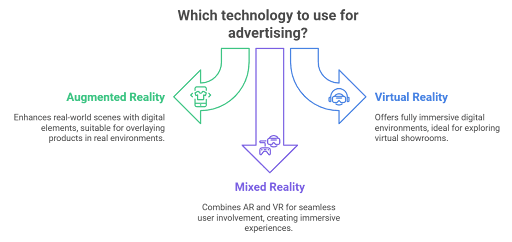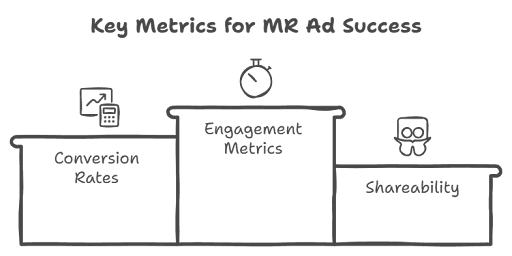Creating Immersive Mixed Reality Ads: A Guide for Marketers and Advertisers
Immersive advertising is redefining how brands connect with their audiences. Mixed Reality (MR), a blend of real-world and digital interactions, has become a cornerstone for creating impactful campaigns. By engaging audiences in unique, interactive ways, MR ads are setting a new standard in storytelling and audience connection.
This guide is designed for marketers and advertisers who want to leverage the power of Mixed Reality and platforms like Flam can help brands launch Mixed Reality Ads.
Understanding the Basics: What Makes an Ad “Mixed Reality”?
Before diving into the Mixed Reality Ad creation, it is necessary to understand how MR is unique. Mixed Reality is not only adding digital elements to a real-world scene. It is also about creating a seamless involvement of users in the experience.

Choosing the Right Type of Mixed Reality for Your Campaign
Not all brands need a full VR experience. For many consumer-focused campaigns, Mixed Reality is a cost-effective and accessible choice, as it can often be integrated through smartphone apps or social media platforms.
Defining Clear Campaign Goals
It is crucial to have clear goals while creating any Mixed Reality Ads. Look into the following while setting objectives:
Key Question | Details |
Who is Your Target Audience? | Younger audiences prefer MR ads on smartphones, while older audiences engage more with in-store MR displays. |
What Action Do You Want Users to Take? | Define the goal—boost purchases, increase brand awareness, or enhance user engagement—to shape the MR experience. |
What Value Will the MR Experience Provide? | Ensure MR offers genuine value, like using AR to help customers visualize furniture at home, simplifying decision-making. |
Note: Always ensure that Mixed Reality campaigns align with your brand objectives broadly, across all categories, from digital channels to physical spaces.
Crafting a Compelling Storyline
Mixed Reality’s greatest advantage is its ability to convey stories in a unique multidimensional way. Creating an memorable immersive experience that leaves lasting impressions is very crucial for the brand.

Focus on the User’s Role
In case of active participants, Mixed Reality Ads are best than traditional ads. Build your storyline around actions that users can take like virtual clothes or virtual try-on of makeup products.
Highlight Brand Values and Identity
Mixed Reality Ads provides an opportunity to present the brand’s personality. For example, a sustainable fashion brand might use AR to illustrate the eco-friendly process behind its products.
Create an Emotional Connection
MR excels in engaging multiple senses. Think about ways to use sound, visuals, and interactivity to make the experience emotionally resonant.
Designing for User Experience (UX)
A smooth and intuitive user experience can make or break a Mixed Reality Ad. Here are some best practices:
Keep it Simple
Overloading users with interactive elements might be overwhelming. It is necessary to be clear on focal points to ensure that users can explore it naturally.
Optimize for Device Compatibility
Ensure that Mixed Reality ads run smoothly on multiple devices. It is necessary to test ads on different models.
Guide the User
Consider providing clear instructions or visual cues for help users understand how to interact with the experience.
Measuring the Success of Mixed Reality Ads

Potential Pitfalls to Avoid in Mixed Reality Ad Campaigns
Some of the potential challenges to avoid during Mixed Reality ad campaigns are mentioned below:
Overly Complicated Interfaces
MR ads should be immersive, not confusing. Too many steps or complex interactions can turn users away. Simplicity is key.
Device Incompatibility
Not all devices support high-end MR experiences. Plan for a broader audience by ensuring compatibility across multiple devices or offering alternative experiences.

Ignoring User Education
Not all consumers are familiar with MR technology. Include simple instructions or guides to help them navigate the experience comfortably.
Note: Conduct usability testing with a small group before launching the full campaign. This feedback can help fine-tune the user experience and address any potential issues.
Choosing Right Flam Tools for Mixed Reality Ads
Flam’s innovative platform positions it as a leader in this space, offering solutions that align with these trends while empowering brands to stay ahead of the curve. Flam offers a suite of tools tailored for different advertising needs:
- Card: Transform print materials into interactive MR experiences.
- Alpha: Create high-quality, immersive ads that captivate audiences.
- Interactive: Engage users with touch-based MR content.
- Multi Interactive: Enable personalized, multi-path interactions, keeping users engaged longer.
Final Thoughts
Brands incorporating Mixed Reality Ads can build strong connections and deliver lasting experiences for their users. The combination of storytelling and interaction is unique and beyond traditional advertising, it ensures users a chance to explore, engage and connect with brands on a deeper level.
MR Ads can be transformative if planned carefully and emphasized on user experience. It ultimately changes the brand interaction with consumers, driving higher engagement and long-term brand loyalty.
Comments
Your comment has been submitted successfully!